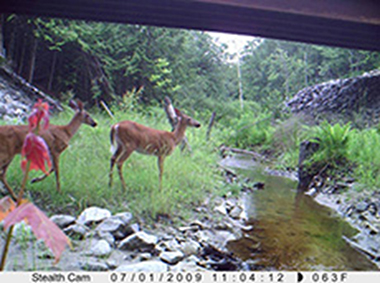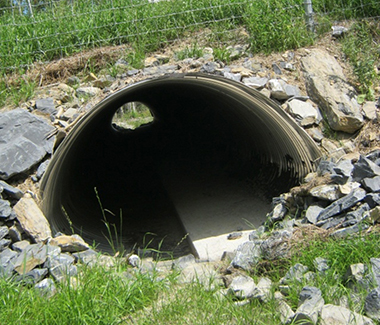Wildlife Crossings Protect Wildlife Along Maine’s Route 112
Wildlife crossings on State highways and local roads provide benefits for animals and road users by reducing habitat fragmentation and animal-vehicle collisions. Wildlife crossings are specially designed bridges, underpasses, culverts, or tunnels that provide safe crossings tailored to fit the needs of local animal populations and the surrounding communities. Roadway projects that include wildlife crossings are often eligible for Federal transportation funding. They can also help to preserve wetlands while reducing highway costs. In 2011, the Federal Highway Administration (FHWA) recognized the Maine Department of Transportation’s (MaineDOT) Gorham Bypass (Route 112) project in Gorham, Maine as an Exemplary Ecosystem Initiative for integrating wildlife crossings into the roadway’s design.

A MaineDOT camera captures deer using one of the wildlife crossings on the Gorham Bypass. (Courtesy of MaineDOT)
Early Considerations of Wildlife and Topography
MaineDOT developed the Gorham Bypass project to alleviate traffic in downtown Gorham, which has worsened over time due to an influx of commuters traveling through Gorham to Portland, Maine’s largest city. The DOT evaluated several project alternatives to improve traffic flow and ultimately decided to extend Route 112 from northwest Gorham to Route 114, allowing travelers to bypass downtown Gorham. This alternative effectively addressed the traffic problems in Gorham, but created another challenge. How could MaineDOT construct a road in a predominantly undeveloped area while minimizing potential disruptions to wildlife habitats?
Since the project’s conception, MaineDOT set out to construct the new roadway surface to be as porous as possible to minimize its impacts to wetlands and animal movements. MaineDOT assessed the habitat impacts from the proposed bypass, as requested by the FHWA Maine Division Office. The DOT also sought input from the U.S. Fish and Wildlife Service on wildlife passages throughout the design process to ensure the road would have minimal wetland and wildlife impacts.
Using this habitat assessment, MaineDOT identified local wildlife species that would benefit from passages, including deer, turkeys, beavers, porcupines, salamanders, and frogs. MaineDOT also looked at the topographic features of the surrounding area to help determine the road geometry and identify locations for potential wildlife crossings early in the planning stage of the project. Two locations were also identified that contained deep streams, which are ideal for large mammal crossings. These places were likely to remain undeveloped due to regulatory protections and topographical challenges, including steep grade and deep streams, and therefore would serve as effective long-term habitats for area wildlife. The lack of development in these areas also allowed MaineDOT to construct a half-mile fence around each wildlife bridge crossing to funnel the animals toward the crossings. The DOT also identified locations for eight 4-foot culvert crossings, including two near vernal pools. Culverts are appropriate for the movement of small mammals, amphibians, and reptiles. Vernal pools are temporary pools that often form during the spring. Several types of amphibians travel to and from vernal pools for breeding purposes.
Design for Wetland Preservation
In addition to early assessment and planning of the crossing locations, MaineDOT consulted with transportation planners and road ecologists from New York, Vermont, and Canada on how to incorporate the most effective wildlife crossing designs into the Gorham Bypass. MaineDOT selected wildlife crossing designs that accommodate both wetland preservation and stormwater management objectives and still meet the main goal to maintain habitat connectivity. For example, road designers will often use concrete culvert boxes as wildlife crossings. These are prefabricated concrete cubical sections that can be constructed under a road as an inexpensive alternative to constructing bridge passages. However, in the case of the Gorham Bypass, the DOT would have incurred higher expenses from the additional filling required to stabilize the concrete box culverts in the passage locations, which had wet, unstable soil. Filling in this area with concrete would have also required additional costly environmental mitigation. MaineDOT determined that constructing two 135-foot bridges was for ensuring safe wildlife passage was fairly comparable in cost as compared to the concrete box option. However, the bridges were structurally simpler to build and would have less impact on the surrounding environment.
To accommodate small animals crossing near vernal pools, MaineDOT constructed 4-foot culverts, which served both as wildlife passages and drainage pipes to direct stormwater from adjacent properties to lower lying areas. The DOT also installed water-permeable silt fences to help funnel small animals to the culverts.

This culvert crossing on the Caribou Bypass includes a shelf to allow terrestrial animals to cross in wet conditions. (Courtesy of MaineDOT)
Results and Future Applications
MaineDOT considers the wildlife crossings along the Gorham Bypass a major success because there are lower animal-vehicle collision rates on this road relative to comparable roads. Between 2008 and 2011, there was one animal-vehicle collision on the Gorham Bypass, compared to 12 animal-vehicle collisions on the adjacent Route 114, a similarly sized road that is east of the bypass, which does not have fencing or wildlife passages. MaineDOT is documenting wildlife use of the bridges and culverts, using Stealth Cam wildlife still cameras and field observations of animal tracks leading to and from the passages. These observations will support future wildlife passage designs.
MaineDOT continues to construct wildlife crossings along highways where applicable, incorporating lessons learned from the Gorham Bypass project. The DOT is also developing new ways to protect wildlife. The recently constructed Caribou Bypass, in the city of Caribou in northern Maine, features a new culvert design that better accommodates wildlife crossings in wet areas. The culvert contains a concrete shelf that allows small animals to cross over water drainage and debris that sometimes collects at the bottom of the culvert.
Since the construction of the Gorham Bypass, MaineDOT has presented its preliminary observations and lessons learned at three annual Northeastern Transportation and Wildlife Conferences to share with other transportation agencies the planning considerations and implications of integrating wildlife passages into roadway construction. The DOT is currently working on an analysis and report of the wildlife crossings on the Gorham Bypass to inform future wildlife crossings along other Maine roadways.
Look What’s New!
- On December 4, 2012, FHWA will host the next Eco-Logical Webinar, which will feature Maine’s Beginning with Habitat program, a collaborative, habitat-based approach to conserving wildlife and plant habitat on a landscape scale. The program provides local officials, committee members, and land trust representatives with habitat data drawn directly from State DOT databases to inform planning decisions. The webinar will be held from 1:00 to 2:00 p.m. (Eastern Time).
Successes in Stewardship is a Federal Highway Administration newsletter highlighting current environmental streamlining and stewardship practices from around the country. To subscribe, visit http://environment.fhwa.dot.gov/sis_registration/Register.aspx or call 617-494-2092.

